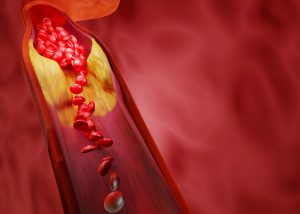Metabolic syndrome is defined by a group of metabolic abnormalities, including hypertension, central obesity, insulin resistance, and high cholesterol. The disease is strongly associated with increased diabetes and heart disease risk.
Risk Factors
When you have at least three of the following risk factors, it’s considered Metabolic Syndrome.
- Having a large waistline- also called abdominal obesity. Having a lot of fat around the stomach area puts you at a greater risk for heart disease than having too much fat in other parts of your body.
- Having a high triglyceride level. Triglycerides are a type of fat found in the blood.
- Having a low HDL cholesterol level or a high LDL cholesterol level. These two types of cholesterol work together to balance the fat levels in blood. HDL is considered “good” cholesterol (think olive oil or fats found in fish), and it helps to remove LDL from blood which is considered “bad” cholesterol. Having high LDL and low HDL increases your risk for heart disease and stroke.
- Having high blood pressure. If your blood pressure stays high over time, it can damage your heart and lead to other health problems.
- Having high blood sugar. Having a mildly high fasting blood glucose level may be an early sign of diabetes.
What can cause metabolic syndrome?
Metabolic syndrome is caused by a combination of inherited traits and lifestyle choices. Typically, those who develop this disease are overweight, have a sedentary lifestyle, and eat an unhealthy diet. People who fall into this category may not feel any different but first would notice developing a larger waistline- this is the most significant indicator of the disease.
You may be at greater risk for developing metabolic syndrome in life if you have any family members who are obese or have diabetes or heart disease. Certain genetic factors do come into play, but you can reduce your risk by the choices you make each day.
Can you cure Metabolic Syndrome?
Yes! Metabolic Syndrome can be reversed. Having metabolic syndrome can lead to diabetes or heart disease, but if diagnosed early you can make certain lifestyle choices to reverse the disorder and reduce your chances of developing a chronic disease.
Singapore’s Ministry of Health recommends getting at least 150 minutes of exercise per week, or roughly twenty minutes daily. That may seem like a lot, but luckily, you don’t need a gym membership and you can get this exercise by changing only a few things to your daily routine. For instance, rather than taking the MRT, try walking or riding a bike around the city; take the stairs instead of the elevator. The best thing you can do though is to find a physical activity or hobby you enjoy. Studies show that you are much more likely to maintain a routine if you enjoy what you’re doing.
When it comes to your diet, keep it simple. Michael Pollan, a food writer, and journalist says he can sum up all he’s learned about food into 7 simple words, “eat food, not too much, mostly plants.” If you eat a lot of meat, you don’t have to become a vegetarian. Simply try new plant-based foods and eat what you find tasty.
How do I make these changes?

If you are trying to make healthy changes, set small attainable goals for yourself. If you’ve ever tried to start a diet or start exercising, but you tend to fall back into previous habits, most probably you’re not setting small enough goals. Make a small change each week. When it comes to getting physical activity, aim for five minutes a day and work your way up to the recommended twenty. The most important thing is to establish a routine that is sustainable. Eventually, you’ll get to the point where you’re not “dieting” but just eating; you’re not “exercising” but living your life.
Still concerned about managing chronic conditions? Speak to a GP or specialist on our panel today
Check out or genetic test kits if you want to assess your likelihood of having metabolic disease





